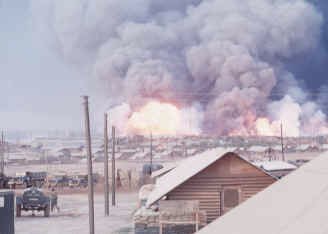Early in January 1968, I was reassigned to Alpha
Battery. I remember spending a couple of weeks in Đông Hà where we were
placed on air defense alert after intelligence reported that the Chinese
were scrambling Russian Illutian fighter bombers to test our air defenses
on the DMZ. The thought of tracking state-of-the-art jet aircraft with our
twin 40mm guns was quite sobering, and I remember being very relieved when
we stood down from our air defense mission.
(While I was at Đông Hà, NVA rockets scored a
direct hit on
the
ammunition dump, which exploded in geysers of flame and
smoke.)
 In mid January I took a section of Alpha Battery Dusters to a newly
constructed combat base called A3 located just below the southern boundary
of the DMZ between Con Thien and Gio Linh. A3 (or Tan An Van Giap,
as it was identified on the map) was a rock-hard patch of dirt hurriedly
scratched out by the engineers, surrounded by barbed wire and minefields
and defended by a company of Marines, some engineers and two
Dusters. As enemy activity increased with the Tet offensive in late
January, we fired harassment and interdiction (H & I) missions every
night into the DMZ. We also used night illumination devices to detect and
target NVA infiltrators as they moved through our area of operations.
Early during the Tet offensive, the Citadel at Hue and the combat base at
Khe Sanh came under heavy NVA attack. As if that were not enough,
the North Koreans captured the Pueblo, and several units of the 3rd Marine
Division were placed on standby alert.
In mid January I took a section of Alpha Battery Dusters to a newly
constructed combat base called A3 located just below the southern boundary
of the DMZ between Con Thien and Gio Linh. A3 (or Tan An Van Giap,
as it was identified on the map) was a rock-hard patch of dirt hurriedly
scratched out by the engineers, surrounded by barbed wire and minefields
and defended by a company of Marines, some engineers and two
Dusters. As enemy activity increased with the Tet offensive in late
January, we fired harassment and interdiction (H & I) missions every
night into the DMZ. We also used night illumination devices to detect and
target NVA infiltrators as they moved through our area of operations.
Early during the Tet offensive, the Citadel at Hue and the combat base at
Khe Sanh came under heavy NVA attack. As if that were not enough,
the North Koreans captured the Pueblo, and several units of the 3rd Marine
Division were placed on standby alert.